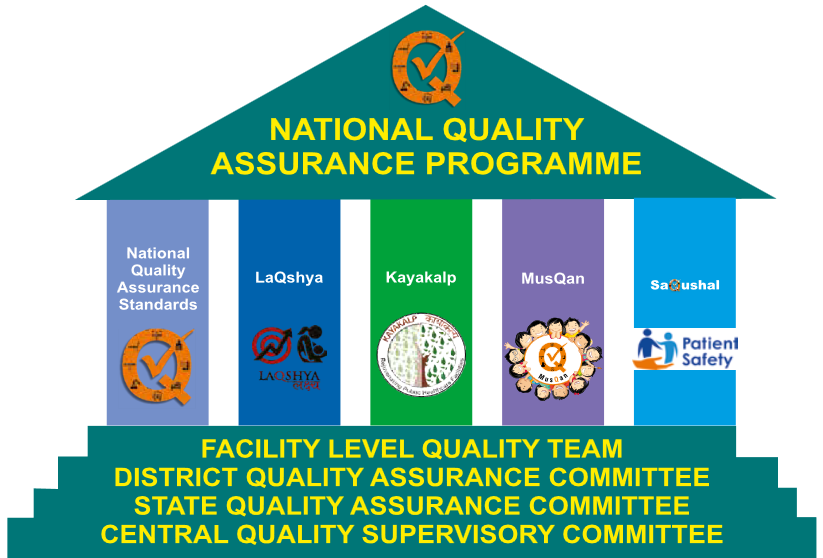Safety and Quality: Self-Assessment Tool for Health Facilities
Safety and Quality: Self-Assessment Tool for Health Facilities
Ensuring safe care is fundamental to patient care, and it is a critical component of quality of care (QoC) along with accessibility, acceptability, effectiveness, efficiency and people-centeredness. It is defined as reduction of preventable errors or harms associated with health care. Globally, patient safety is being recognised as an issue of concern, influencing the attainment of improved health outcomes.
The assessment tool ‘SaQushal’ aims to enhance the visibility and implementation of patient safety practices in health care facilities. The initiative provides a framework through which a health facility can access its status in terms of patient safety and take action to deliver safer patient care.
Scope
Ministry of Health and Family Welfare has released the Patient Safety Self-Assessment Tool to meet the diverse need of public health facilities in the country. It elaborates scope, objectives, institutional arrangement for implementation, assessment methodology, action planning methodology, etc.
The purpose is to provide implementation guidance to the policy makers, program managers, quality nodal officers at state, district, and facility level, etc. to improve patient safety at all levels of facility-based care.
Overview of SaQushal
SaQushal assesses hospitals from patient safety perspective; builds capacity of the staff in patient safety with requisite knowledge & skills; and supports patients and families in decision making. It also strengthens evidence-based practice necessary for improving patient safety and quality of health care.
SaQushal is expected to establish a circle of continuous learning by instituting a reporting and learning system wherein due consideration is also given to human ergonomics for safety with mutual respect for service providers and seekers.
Patient Safety is an integral part of National Quality Assurance Programme, which includes quality activities such as Kayakalp, LaQshya and MusQan.
SaQushal Institutional Framework

Overview - measurement system for Self-Assessment tool
Underlying principles of the assessment tools are summarised below:
- Comprehensiveness – The proposed system is all inclusive and captures all aspects of patient safety within the four areas of concerns namely, safe patient care processes, clinical risk management, safe care environment, patient safety system. The self-assessment tool is transposed within sixteen standards, commensurate measurable elements and checkpoints provide an exhaustive matrix to capture all aspects of safety and quality at the Public Health Facilities.
- Contextual – The proposed system has been developed primarily for meeting the requirements of the Public Health Facilities; since Public Hospitals have their own processes, responsibilities, and peculiarities.
- Contemporary – Contemporary Patient Safety assessment tool such as Patient Safety Friendly Health Facilities, NQAS, Australian Commission on Safety and Quality and JCI have been consulted and their relevant practices have been incorporated.
- User Friendly – Conscious efforts have been taken to avoid complex language and jargon, so that the tools remain user-friendly for ease of understanding and implementation by the service providers. Scoring system has been made simpler with uniform scoring rules and weightage. Additionally, a formula fitted excel sheet tool has been provided with the scheme for the convenience, and also to avoid calculation errors. The workable excel sheets and print ready version of the checklists can be downloaded from https://nhsrcindia.org/QImicrosite
- Evidence Based – The areas of concerns and standards have been developed after consulting contemporary resource available on the patient safety. All respective operational and technical guidelines related to secondary care and National Health Programmes have been factored into.
- Objectivity – Ensuring objectivity in measurement of the Safety and Quality has always been a challenge. Therefore, in the proposed self-assessment tool, each standard is accompanied with measurable elements & checkpoints to measure compliance to the standard. At the end of assessment, there would be numeric scores, bringing out extent of safe care in a snapshot, which can be used for monitoring, as well as for inter-hospital/inter-state(s) comparison.
- Flexibility – The proposed system has been designed in such a way that states and Health Facilities can adapt the system according to their priorities and requirements. State or facilities may pick one or two areas of concerns in the initial phase for ensuring safe care.
- Balanced – All three facets of Safety – Clinical Care, Environmental & System issues, have been given due weightage.
- Transparency – All efforts have been made to ensure that the measurement system remains transparent, so that assesses, and assessors have similar interpretation of each tracer.
- Enabler – Though the tool is primarily meant for the self-assessment, it can also be used as a ‘roadmap’ for attainment of Quality certification under the NQAS.
Arrangement of Self-Assessment tool
Since considerable awareness exist in the health system regarding NQAS & Kayakalp, the arrangement of SaQushal amalgates both these approaches, as elaborated below:
- Area of Concern (AOC): These are broad area/ themes for assessing different aspects of the safety viz. Patient Care Processes, Clinical Risk Management, Safe Care Environment, and Patient Safety Systems
- Standard: These are generic statement of commitments under each area of concern
- Measurable Element: These are the specific elements of safe care under each standard
- Checkpoint: These are few of specific attributes of a measurable elements which should be looked into for assessing the degree of compliance.
- Means of Verification (MOV): Tangible measurable checkpoints are those, which are expected to be objectively observed and scored.
To view the complete document, click here.
Source : Ministry of Health and Family Welfare
Last Modified : 9/19/2023
Provides information about Patient safety.
Provides information about World Patient Safety Da...
